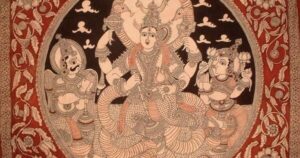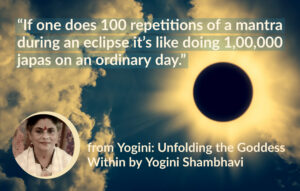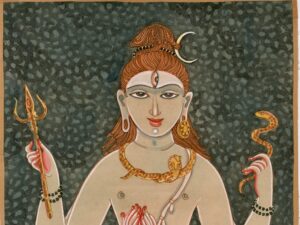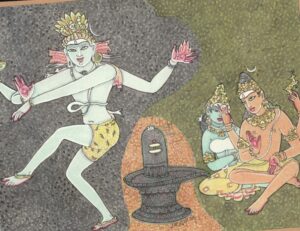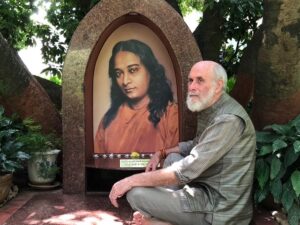The Myth of the Aryan Invasion was first written in 1994 in order to summarize important new information on the ancient history of India that refutes commonly held views on the subject inherited from the nineteenth century. It was a condensation of longer material from books of mine like Gods, Sages and Kings, Vedic Aryans and the Origins of Civilization (with N.S. Rajaram) and In Search of the Cradle of Civilization (with Georg Feuerstein and Subhash Kak). The 2001 update reflected my recent book Rigveda and the History of India that pushed the Vedic horizon further into the South India.
The 2005 edition reflects information from a new book that N.S. Rajaram and I have completed for the Swaminarayan movement and their new Delhi temple Akshardham, the largest to come up in the city in perhaps centuries, and its cultural displays. That book (Hidden Horizons: Unearthing 10,000 Years of Indian Culture) takes the origins of the Vedic age further back in time and in the direction of Southeast Asia.
The amount of information available relative to ancient India is now much more extensive than that considered in old textbooks still used in India’s schools and in most schools in the West. Numerous new archaeological finds, including several larger than Harappa, the geology of the Sarasvati River, the natural history of the region, Southeast Asia as the homeland for most human populations prior to the end of the last Ice Age, new views of genetics, new theories of linguistics, archaeo-astronomy, and a greater sensitivity to Vedic texts and their vast spiritual and cultural implications, are only part of the new fabric to be woven in order to really understand ancient India.
Whether one may agree with the details, it is clear that the ancient history of India needs to be totally recast. The history and cultural heritage of India is largely an indigenous development of the same basic peoples that have inhabited the region for over ten thousand years, as they have adapted to their environment and also discovered its spiritual essence in its great mountains, rivers and oceans. It is time to look at the history and culture of India as a whole, organically, and in an integral manner according to its own internal impetus as the primary factor.
Older views of India based on outside migrations, external cultural influences and foreign borrowings as the primary forces are the products of a failure to understand the real soul and spirit of India. In the twenty first century in which the antiquity of cultures all over the world is being extended back centuries, if not thousands of years, there is no need to keep the history of India frozen around speculative events of 1500 BCE that have so far failed to prove themselves. It is time to open the door on India’s great ancient heritage that takes us back to the very dawn of time. This primary message of the book remains the same.
2005 Update
More on the Southern Connection: The Findings of Natural History
Southeast Asia and the End of the Ice Age Migrations
Probably the most important development in the study of ancient India over the last five or ten years has been new evidence relative to genetics and natural history. This shows the antiquity of Indian populations in India and a strong connection with Southeast Asia going back to the Ice Age period.
Such information supports the southern connection to the Vedic culture based that I have proposed, starting with the maritime symbolism of the Rig Veda highlighted in my first book on the subject Gods, Sages and Kings (1991). It was an important theme in my Rig Veda and the History of India (2001) and in previous editions of this current volume. These connections have also been addressed in books and articles by Subhash Kak, S. Kalyanaraman, N.S. Rajaram and many others. The more specific scientific data on the importance of Southeast Asia as a possible source of most ancient post-Ice Age cultures can be found in the work of Stephen Oppenheimer as in his books like Eden in the East.
The southern basis for the Vedic culture is based upon two important points of natural history. The first is the geology of the Sarasvati River in the post-Ice Age period. The second is the dominance of South India and Southeast Asia as a major site of human habitation during the Ice Age period, and migration from it in the post-Ice Age era – when the region was flooded – as probably the main impetus for the development of cultures to the north and west extending perhaps as far as Europe.
We have already discussed the first major point of natural history relative to ancient India in the earlier sections of the book. The development of agriculture and urban civilization in ancient India was based upon the geology of the Sarasvati River, which arose as a mighty river towards the later period of the last Ice Age over 10,000 years ago, and lost its perennial flow, owing to the later climate changes and the melting of the main glaciers in the 2200-1500 BCE era. This Vedic-Sarasvati culture, relative to its geology, lasted from around 10,000-2000 BCE, when the Sarasvati was the dominant river in North India. This perennial great Sarasvati defines the main period of the development of Vedic culture, Vedic kingdoms and the late Vedic era, when the Sarasvati began to decline. This is roughly the period from the older Rigvedic Hymns to the later four Vedas, Brahmanas and early Upanishads, though it is likely that the existent texts which we have were not entirely finalized until the end of this period.
The second and related point, which is now assuming more significance, is that this Vedic civilization was based upon an older proto-Vedic culture in the south of India and Southeast Asia prior to the end of the last Ice Age. Prior to the end of the last Ice Age, when sea levels were much lower, the most favorable part of the globe for human habitation was Southeast Asia, which included the region from South India to Indonesia. Indonesia was not a series of islands but was connected to Malaysia as part of a large subcontinent called Sunda Land. This region had the warmest and wettest climate of the Ice Age period and was the main center of human habitation and probably human culture as well. Regions to the north were not only colder but drier, including north India, with little monsoon developing in the summer and little melting of glacial ice from the winter to support much by way of great rivers.
This idea of Sunda Land has points in common with the idea of Kumari Kanda, of South India connecting to a larger continent to the south at a remote ancient period. It is also reflected in the maritime symbolism which pervades the Rig Veda and in the idea of pre-flood or pre-Manu kings and dynasties like that of Prithi Vainya, who is credited with first introducing agriculture to humanity, as well as in the idea of earlier kalpas or world-ages and earlier Manus that we find in the Puranas.
The end of the Ice Age released the waters to flow through the Sarasvati River and inundate the plains of North India, turning the area into an ideal region for habitation and agriculture. We can easily see this geological event in Vedic stories of the great Indra, slaying the dragon Vritra, who lay at the foot of the mountains holding back the waters, releasing the seven rivers to flow into the sea.
The end of the Ice Age caused a migration of peoples from Southeast Asia to the north and west, fleeing the rising waters that put much of the Indonesian area under sea and separated Sri Lanka from India. North India would have been one of the first and most accessible places of migration for those seeking to flee the end of the Ice Age floods, either by sea or by land routes. We see this in Hindu myths of Manu as a flood figure coming from Kerala in South India, as in the Matsya Purana, as well as in the underlying maritime symbolism and ocean worship in the Rig Veda itself.
Older Patterns: India and Southeast Asia and Human Populations
A third important point of natural history is that this movement of populations out of Southeast Asia at the end of the last Ice Age reflects an even older pattern of movements. According to recent science and genetics, modern man arose in Africa about 200,000 years ago and from there spread first into India and Southeast Asia by a coastal migration. According to the geneticist Stephen Oppenheimer, settlements in India appear about 90,000 years ago. From India there were later northeastern and northwestern migrations into Eurasia and the Far East. India has long been a focal point of this movement from Southeast Asia to the Middle East, Central Asia and Europe.
A recent paper in the journal Science reporting on the analysis of the DNA of the Orang Asli, the original inhabitants of Malaysia, confirms this view. According to it a single migration out of Africa took the southern route to India, Southeast Asia and Australasia. At this time Europe was too cold for human habitation. About 50,000 years ago, when deserts turned into grasslands, an “Out of India” migration populated the Near East and Europe, another migration went northeast through China and over the now submerged Bering Strait into the Americas. This agrees with the earliest known modern human sites of the Near East (45,000 years ago) and Europe (40,000 years ago). It is likely that the earliest sites on the coastline that were occupied by the first migrants are now under water, since sea level has risen more than sixty metres since the last Ice Age.
So a movement out of India and Southeast Asia has been occurring for tens of thousands of years. But the movement after the end of the last Ice Age was the most crucial for current human populations. Geneticists like C. Cavalli-Sforza and S. Oppenheimer have noted that settlers in the coastal regions of India were the source (‘inocula’) for the population of India. Some of them later migrated northwards and westward to populate Europe. This is the exact reverse of the various migration-invasion theories (like the Aryan invasion) advanced by linguists and anthropologists who sought to derive Indians and their civilization from Central Asia, Eurasia or even Europe. See for example, Eden in the East by Stephen Oppenheimer (2003), London: Constable. This is discussed in more detail in later chapters.
Hindu View of Time and History
The Hindu idea of earlier Manus (humanities) and earlier kalpas or world-ages, such as we find in Puranic literature, may reflect memories of these earlier phases of mankind prior to what our current culture recognizes as history. This Hindu connection to prehistoric phases of the human species may be responsible for the Hindu idea of an eternal tradition of truth (Sanatana Dharma), and its recognition of cyclic movements of human civilization over many tens of thousands of years, such as we find in Puranic Yuga cycles.
From the standpoint of modern science, this ‘Hindu view of time’ better reflects the movement of natural history that is marked by cycles and cataclysms over long time periods. This is in contrast to western historical models that follow a linear and progressive model of history, culture and religion towards some sort of heaven or utopia, based upon a limited time horizon of about five thousand years that stands apart from nature’s cycles and often tries to oppose them. As we move into a more ecological age and gain a greater respect for natural history, we must reformulate our cultural history accordingly, which will take us more in the direction of this Hindu view of time, humanity and the universe.
Languages and Natural History
Ancient languages, like the populations and cultures, mainly arose as efforts to adapt to the natural environment. Languages were not simply affairs of the last five thousand years but have existed for tens of thousands of years, as long as the species, and have also been strongly impacted by natural history.
We can trace the movement of languages along with this movement of peoples, who would not have been mute. Such early ancient peoples would have kept their languages in tact as best they could because they relied on the spoken language as the main repository of their culture. This would require making ancient language groups, including the Indo-European family, much older, arising eight to ten thousand years ago along with flood changes and migrations. It is even possible that currently recognized language groups reflect languages formed and spoken even longer back in the Ice Age Period.
This movement of peoples out of India and Southeast Asia at the end of the Ice Age can provide the impetus for the spread of Indo-European languages north and west into Europe and Central Asia, regions that in the Ice Age era could only hold very small if any populations, having a climate that resembles Tibet (as a cold dry desert). Or perhaps it began even earlier, in some of the warm interludes that did occur during the latter portions of the Ice Age.
The end of the Ice Age afforded the natural events to create widespread migrations from populated to unpopulated regions. The much later proposed migrations, like those speculated for the Aryans into India around 1500 BCE – which still has yet to be proved to have occurred at all – do not have this natural justification. They are proposed migrations from unpopulated to populated and from uncultured to cultured regions that could not count for so much in terms of cultural changes.
Yet even such shifts of people in the late ancient period appear to be related to climate changes and droughts that began around 2200 BCE, which also led to the drying up of the Sarasvati River in India, but this was another movement out of India or a relocation inside of India from the Sarasvati to the Ganga.
Language Families
India is not only the eastern focus of Indo-European languages; it is also the western focus of Indo-Pacific languages. The Indo-Pacific family covers the languages of the Australian aborigines and the Papuans. The Austro-Asiatic cuts across from India to the Pacific (the Munda in India, the Thai, and the Vietnamese), extending to Madagascar.
Indian languages of both the Sanskritic and Dravidian groups have considerable affinities and connections with Pacific languages. These have not been adequately explored owing to the obsession with PIE (Proto-Indo-European) relative to Europe and Central Asia that has kept scholars from taking Indian languages further south and east. Both Sanskritic and Dravidian languages of India have considerable connections with the Munda and Southeast Asian languages that they have been in physical proximity to, which has been throughout the historical period. These Pacific languages similarly have their connections with Dravidian and Sanskritic languages.
Within India, the connections between the structure and vocabulary of the north and the south Indian languages indicate much internal migration of people and diffusion of culture, linking not only India to the Central Asia, but more importantly, India to the Pacific region and to Southeast Asia.
In addition, it is not only the Indo-European languages that connect India with Central Asia. The Dravidian languages also have connections with the Altaic family of languages that includes the Japanese, Korean, and the Turkic. That is why western scholars have proposed similar Dravidian migrations into India in late ancient times – a kind of Dravidian invasion theory much like the Aryan Invasion idea, sometimes dated even after it, making the Dravidians into post-Aryan migrants into the region – to explain the connection of Dravidian languages in India with those in Central Asia. This was the view of Bishop Caldwell who first brought up the idea of a Dravidian family of languages.
These Aryan and Dravidian invasion models would make the dominant language families of India intruders from the northwest at a late period. Such an idea is contrary to the natural history and the fact that India had stable populations and a cultural continuity throughout the ancient period. A much more likely scenario is that both Dravidian and Sanskritic languages developed in India and their influence spread to the northwest along with the movement of peoples in the Post-Ice Age era. This makes India an important central focus for not only populations, but for many of the languages of the world.
The Indo-European languages and the Dravidian are probably offshoots of such an older Indo-Pacific group of languages. Ancient South India at the time of the end of the Ice Age was probably the home of a proto-Vedic culture and of languages that later gave rise to both Dravidian and Sanskritic groups.
Languages like peoples developed regionally, were occasionally displaced by powerful natural events, and spread also by communication. Languages like populations cannot be defined by the lesser migrations of the late ancient period, by which time most population bases were already defined. They should be related to earlier and more powerful events.
Religion and Culture of Southeast Asia
The Vedic religion of India has much in common with other Indo-European religions from Persia to Ireland in terms of practices, rituals and traditions. These include fire worship, ritual chanting, sacred plants and many other factors, such as has been the subject of many studies East and West.
However, similar connections exist between the Vedic and Southeast Asian religious and cultural traditions. While India and Southeast Asia shared Buddhist and Hindu traditions during the historical period, it is now becoming more likely they did so in the prehistoric era as well. We also need to examine the similarities between Vedic rituals, customs and yoga practices and older traditions of Southeast Asia, which, incidentally, also had fire worship and a cult of sacred plants (Soma).
One of the main mistakes of modern scholarship, relying uncritically on its own preconceptions about culture, is to not even bother to look for such connections. The artificial barriers put up by old theories that Indian civilization came from the West have to be eliminated. Southeast Asia has been regarded by western historians as an even more a cultural backwater than India because they regard it as having borrowed from India what India itself borrowed from the West! These ideas also need to be set aside. Southeast Asia may prove more important as a cradle for human populations and culture than the Middle East.
Many of the earliest agricultural sites have been found in Southeast Asia in the late Ice Age period more than ten thousand years ago. It is also likely that other cultural innovations usually credited to the Middle East may have arisen in this region. These were less likely to survive the course of time owing to sea level changes and the effects of a wet tropical climate, as well as probably building more with wood than stone.
The Hindu view that cycles of time are reflected in cycles of consciousness and civilization also deserves serious consideration. We cannot impose our current historical mindset on previous eras, particularly for eras thousands of years ago, and expect to understand them. Their mentality, culture and usage of language would have been according to the influences of their time and environment.
One of the great limitations of modern linguistics is that it tries to reconstruct ancient languages as if the ancients formed words and thought the way we did. In tracing ancient languages and their movement, we should also strive to be more sensitive as to their nature and symbolism. Similarly, when we use modern theories like Marxism, Freudian psychology or even monotheistic religions to understand the early ancient world, we are imposing alien ideas upon them that cannot reveal their true character.
An Integrated Approach
The tendency of modern scholarship of ancient India has been to make the culture, languages and peoples of the region into outsiders, coming fairly late in the ancient historical period. Such new and more scientific evidence shows that the peoples of India can no longer be made into recent immigrants. This makes it very difficult to superimpose their languages or cultures upon them at a late period as well. All these factors are intimately connected to the natural environment and natural history of the region.
In other words, in order to understand ancient India we must look at the natural history, languages, culture and peoples together. We cannot attribute the languages, peoples or culture of India to groups from outside of India, which India absorbed like a vacuum. Languages, peoples and cultures were already there and in abundance, as India has always been a very fertile ground for human development. Nor can we have these cultures like the Harappan mysteriously disappear or become replaced in the late ancient period, particularly when there is no evidence to support it. There is nothing mysterious about Harappan civilization or it’s arise or it’s fall. It is very Indian much like the later classical cultures of the region in arts, crafts, town planning, agriculture, tools or religious symbolism. We cannot divide it off into another stream which left no trace.
It is better to look at India as it truly is, as a natural geographical, cultural, linguistic, and population zone. We must recognize an indigenous development of civilization in India relative to the factors of natural history and shared environment defined by the geography of the Himalayas to the sea that we find even in ancient texts. This connects India geographically more with Southeast Asia, and in terms of time frame, with movements of people and climate changes at the end of the last Ice Age, not in the 1500 BCE era.
What is most remarkable is that India preserves an ancient literature that with its knowledge of the ocean and the Sarasvati River accurately reflects the natural history. Putting all these factors together is like putting together the pieces of a puzzle. Instead of a puzzle with most pieces missing, as has been the recent western view of ancient India, it restores the picture to its whole.
The idea of India as a cultural patchwork is the result of poor or preliminary scholarship that has been unable to reconstruct the whole, like the blind man who cannot see the elephant as a whole. Once we add in the complete picture as revealed both by the natural history and the literature of the region, what we see instead is India as one of the most important centers not only for human spirituality through its great religions, but also of populations, languages and culture back to the period of prehistory. This is new view of India that will replace the current old worn distortions that are held up more by politics and by inertia than by anything else.
In other words, in order to understand ancient India we must look at the natural history, languages, culture and peoples together. We cannot attribute the languages, peoples or culture of India to groups from outside of India, which India absorbed like a vacuum. Languages, peoples and cultures were already there and in abundance, as India has always been a very fertile ground for human development. Nor can we have these cultures like the Harappan mysteriously disappear or become replaced in the late ancient period, particularly when there is no evidence to support it. There is nothing mysterious about Harappan civilization or it’s arise or it’s fall. It is very Indian much like the later classical cultures of the region in arts, crafts, town planning, agriculture, tools or religious symbolism. We cannot divide it off into another stream which left no trace.
It is better to look at India as it truly is, as a natural geographical, cultural, linguistic, and population zone. We must recognize an indigenous development of civilization in India relative to the factors of natural history and shared environment defined by the geography of the Himalayas to the sea that we find even in ancient texts. This connects India geographically more with Southeast Asia, and in terms of time frame, with movements of people and climate changes at the end of the last Ice Age, not in the 1500 BCE era.
What is most remarkable is that India preserves an ancient literature that with its knowledge of the ocean and the Sarasvati River accurately reflects the natural history. Putting all these factors together is like putting together the pieces of a puzzle. Instead of a puzzle with most pieces missing, as has been the recent western view of ancient India, it restores the picture to its whole.
The idea of India as a cultural patchwork is the result of poor or preliminary scholarship that has been unable to reconstruct the whole, like the blind man who cannot see the elephant as a whole. Once we add in the complete picture as revealed both by the natural history and the literature of the region, what we see instead is India as one of the most important centers not only for human spirituality through its great religions, but also of populations, languages and culture back to the period of prehistory. This is new view of India that will replace the current old worn distortions that are held up more by politics and by inertia than by anything else.
In other words, in order to understand ancient India we must look at the natural history, languages, culture and peoples together. We cannot attribute the languages, peoples or culture of India to groups from outside of India, which India absorbed like a vacuum. Languages, peoples and cultures were already there and in abundance, as India has always been a very fertile ground for human development. Nor can we have these cultures like the Harappan mysteriously disappear or become replaced in the late ancient period, particularly when there is no evidence to support it. There is nothing mysterious about Harappan civilization or it’s arise or it’s fall. It is very Indian much like the later classical cultures of the region in arts, crafts, town planning, agriculture, tools or religious symbolism. We cannot divide it off into another stream which left no trace.
It is better to look at India as it truly is, as a natural geographical, cultural, linguistic, and population zone. We must recognize an indigenous development of civilization in India relative to the factors of natural history and shared environment defined by the geography of the Himalayas to the sea that we find even in ancient texts. This connects India geographically more with Southeast Asia, and in terms of time frame, with movements of people and climate changes at the end of the last Ice Age, not in the 1500 BCE era.
What is most remarkable is that India preserves an ancient literature that with its knowledge of the ocean and the Sarasvati River accurately reflects the natural history. Putting all these factors together is like putting together the pieces of a puzzle. Instead of a puzzle with most pieces missing, as has been the recent western view of ancient India, it restores the picture to its whole.
The idea of India as a cultural patchwork is the result of poor or preliminary scholarship that has been unable to reconstruct the whole, like the blind man who cannot see the elephant as a whole. Once we add in the complete picture as revealed both by the natural history and the literature of the region, what we see instead is India as one of the most important centers not only for human spirituality through its great religions, but also of populations, languages and culture back to the period of prehistory. This is new view of India that will replace the current old worn distortions that are held up more by politics and by inertia than by anything else.

